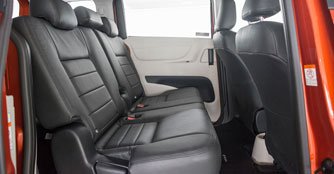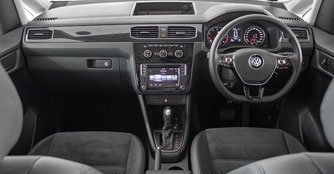Toyota Sienta 1.5 Elegance (A) vs Volkswagen Caddy MPC 1.4 TSI DSG (A)
18 Nov 2016|29,964 views
As much as I'd love to own a hot hatch for as long as I live, the reality of life is that we'd likely get hitched, become parents and give in to Multi-Purpose Vehicle (MPV) ownership.
I used to bemoan the idea of such a reality, but I suspect many car manufacturers have heard my animalistic cries because slowly but surely, the MPV is evolving and improving. And because of this, I have begun not hating them quite as much.
Two of such cars, which have remarkably changed my perception are the BMW 2 Series Gran Tourer and the Honda Jade RS but, that's another story for another time. Today we study two cars, which aren't as sporty, but more economical and just as purposeful, if not more. Let's find out whether the Toyota Sienta or the Volkswagen Caddy makes a nicer family pet.

Visual value
Until private-hire companies decided to use the Sienta for services like Uber, plying our roads like a sea of ants in a forest, we found the Sienta to be quite pleasing to our eyes. Inspired by an 'urban tracking shoe' design, the quirky Sienta cuts quite a distinctive figure on the road. Its futuristic lines make it a more eye-catching car, compared to its hearse-like competitor.
To be fair, despite the Caddy's unpopular boxy shape, it's the tougher and more premium of the two. It sports a front-end familiar to the new generation Volkswagen models - the fascia is remarkably similar to the new Touran.
Living spaces
However, exterior design is but a secondary concern for MPV buying - space and comfort on the inside are of utmost importance.
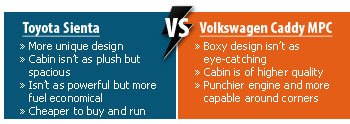 |
Inside the $9,012 cheaper Sienta (as of 11th November 2016), you get a cabin clad in hard plastics. Everything from the seats, knobs and infotainment system are cheaper to the touch than the its German rival's.
While driving, there is also significantly more road and wind noise echoing through its cabin. Nitpicking aside, at the end of the day, Toyota knows that Sienta buyers are after ultimate practicality rather than a plush interior. And, it's in the practicality department where the Sienta doesn't disappoint.
Boot space can be expanded to 575 litres with the third row of seats folded down. There is also a neat system to fold down the third row of seats - they can be tucked underneath the second row, making for a flat and easy-to-load boot.
In the Caddy, the dashboard is cleanly designed, ranks high on quality and refinement, and you get the usual sense of German familiarity and user-friendliness.
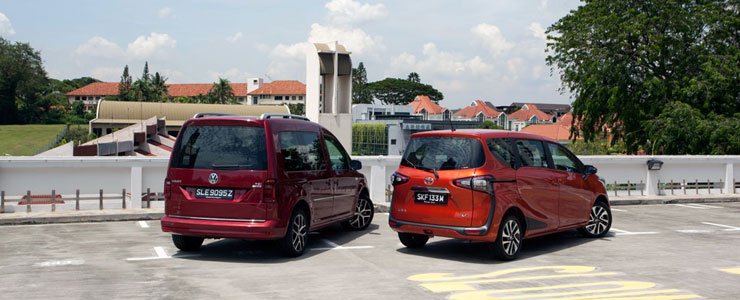 |
Its leather and Alcantara seats are more comfortable than the Sienta's, and despite having a shorter wheelbase, the Caddy doesn't feel any less spacious. All passengers get plenty of headroom and there are many storage cubbies constructed around the interior.
Its second row of seats are 60:40 split-folding, and a cargo capacity of 750 litres with the last bench stowed away is simply humongous. The second and third row of seats can also be removed, allowing the Caddy to revert to its more commercial roots.
The one downside to life in the Caddy is a lack of power sliding doors, found in the Sienta. But, it does have an interesting microphone system that amplifies what people in the front are saying, to those behind.
One punches a lot harder
When push comes to shove, the Sienta's naturally aspirated 1.5-litre engine struggles to keep pace with the Caddy. The Toyota engine produces just 106bhp and 140Nm of torque and to get going, you'd have to push upwards of 4,000rpm - that's driving alone. God knows how much it'll struggle under the weight of a full family load.
Under the hood of the Caddy is Volkswagen's force-fed 1.4-litre lump, which churns out 123bhp and 220Nm of torque. This makes the Caddy a good two seconds quicker than the Sienta from 0-100km/h even though the former is 64kg heavier.
When straights turn bends, the Caddy is also a lot more planted and confident than the Sienta.
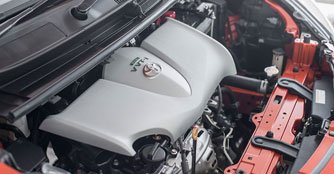
The Sienta is, however, slightly more fuel efficient at 14km/L compared to the Caddy's 13.6km/L.
You get what you pay for
At time of writing, the Sienta is priced $9,012 lower than the Caddy. Over 10 years of ownership you'd be saving $901.20 a year (about $75 a month), exclusive of maintenance and petrol if you purchase the Sienta.
However, fork out $75 more a month and you get German design, quality and ergonomics, on top of a considerably superior drive.
That's $75 we won't mind spending. Neither would our wives, children or parents for that matter.
As much as I'd love to own a hot hatch for as long as I live, the reality of life is that we'd likely get hitched, become parents and give in to Multi-Purpose Vehicle (MPV) ownership.
I used to bemoan the idea of such a reality, but I suspect many car manufacturers have heard my animalistic cries because slowly but surely, the MPV is evolving and improving. And because of this, I have begun not hating them quite as much.
Two of such cars, which have remarkably changed my perception are the BMW 2 Series Gran Tourer and the Honda Jade RS but, that's another story for another time. Today we study two cars, which aren't as sporty, but more economical and just as purposeful, if not more. Let's find out whether the Toyota Sienta or the Volkswagen Caddy makes a nicer family pet.
Visual value
Until private-hire companies decided to use the Sienta for services like Uber, plying our roads like a sea of ants in a forest, we found the Sienta to be quite pleasing to our eyes. Inspired by an 'urban tracking shoe' design, the quirky Sienta cuts quite a distinctive figure on the road. Its futuristic lines make it a more eye-catching car, compared to its hearse-like competitor.
To be fair, despite the Caddy's unpopular boxy shape, it's the tougher and more premium of the two. It sports a front-end familiar to the new generation Volkswagen models - the fascia is remarkably similar to the new Touran.
Living spaces
However, exterior design is but a secondary concern for MPV buying - space and comfort on the inside are of utmost importance.
Inside the $9,012 cheaper Sienta (as of 11th November 2016), you get a cabin clad in hard plastics. Everything from the seats, knobs and infotainment system are cheaper to the touch than the its German rival's.
While driving, there is also significantly more road and wind noise echoing through its cabin. Nitpicking aside, at the end of the day, Toyota knows that Sienta buyers are after ultimate practicality rather than a plush interior. And, it's in the practicality department where the Sienta doesn't disappoint.
Boot space can be expanded to 575 litres with the third row of seats folded down. There is also a neat system to fold down the third row of seats - they can be tucked underneath the second row, making for a flat and easy-to-load boot.
In the Caddy, the dashboard is cleanly designed, ranks high on quality and refinement, and you get the usual sense of German familiarity and user-friendliness.
While driving, there is also significantly more road and wind noise echoing through its cabin. Nitpicking aside, at the end of the day, Toyota knows that Sienta buyers are after ultimate practicality rather than a plush interior. And, it's in the practicality department where the Sienta doesn't disappoint.
Boot space can be expanded to 575 litres with the third row of seats folded down. There is also a neat system to fold down the third row of seats - they can be tucked underneath the second row, making for a flat and easy-to-load boot.
In the Caddy, the dashboard is cleanly designed, ranks high on quality and refinement, and you get the usual sense of German familiarity and user-friendliness.
Its leather and Alcantara seats are more comfortable than the Sienta's, and despite having a shorter wheelbase, the Caddy doesn't feel any less spacious. All passengers get plenty of headroom and there are many storage cubbies constructed around the interior.
Its second row of seats are 60:40 split-folding, and a cargo capacity of 750 litres with the last bench stowed away is simply humongous. The second and third row of seats can also be removed, allowing the Caddy to revert to its more commercial roots.
The one downside to life in the Caddy is a lack of power sliding doors, found in the Sienta. But, it does have an interesting microphone system that amplifies what people in the front are saying, to those behind.
One punches a lot harder
When push comes to shove, the Sienta's naturally aspirated 1.5-litre engine struggles to keep pace with the Caddy. The Toyota engine produces just 106bhp and 140Nm of torque and to get going, you'd have to push upwards of 4,000rpm - that's driving alone. God knows how much it'll struggle under the weight of a full family load.
Under the hood of the Caddy is Volkswagen's force-fed 1.4-litre lump, which churns out 123bhp and 220Nm of torque. This makes the Caddy a good two seconds quicker than the Sienta from 0-100km/h even though the former is 64kg heavier.
When straights turn bends, the Caddy is also a lot more planted and confident than the Sienta.
The Sienta is, however, slightly more fuel efficient at 14km/L compared to the Caddy's 13.6km/L.
You get what you pay for
At time of writing, the Sienta is priced $9,012 lower than the Caddy. Over 10 years of ownership you'd be saving $901.20 a year (about $75 a month), exclusive of maintenance and petrol if you purchase the Sienta.
However, fork out $75 more a month and you get German design, quality and ergonomics, on top of a considerably superior drive.
That's $75 we won't mind spending. Neither would our wives, children or parents for that matter.
Car Information
Volkswagen Caddy MPC Petrol 1.4 TSI DSG (A)
CAT A|Petrol|17.2km/L
Horsepower
92kW (123 bhp)
Torque
220 Nm
Acceleration
10.9sec (0-100km /hr)
This model is no longer being sold by local distributor
All Used Volkswagen Caddy MPC PetrolToyota Sienta 1.5 Elegance (A)
CAT A|Petrol|16.1km/L
Horsepower
78kW (105 bhp)
Torque
140 Nm
Acceleration
12.8sec (0-100km /hr)
This model is no longer being sold by local distributor
All Used Toyota SientaThank You For Your Subscription.



































